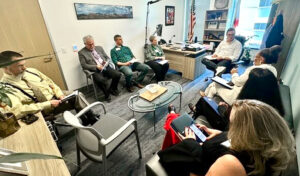While we all are grateful to leave 2020 behind us, the first several months of the new year will not provide any respite from the relentless spread of COVID-19, especially in these early weeks as the holiday gatherings transform into mass hospitalizations throughout California.
The projections are frightening. As many as 15,000 new COVID-19 patients could need hospital care by the middle of this month, and the cases will continue to climb through late February before things might begin to level off.
A state health order issued on Tuesday and amended Wednesday lacks many of the key flexibilities hospitals need to manage through the most challenging period of the pandemic, and additional steps must be taken to avert the worsening crisis.
The order does two things: directs hospitals in counties overwhelmed by COVID-19 to suspend non-essential surgeries, and allows the state to direct the transfer of patients from certain hospitals, requiring other hospitals to accept those transfers “when capable and clinically appropriate.”
Many hospitals in affected areas have already suspended non-essential surgeries as ICUs throughout the state are bursting at the seams, but the application of this suspension to ASCs is troubling. With regard to patient transfers, the approach in this health order does not address critical capacity issues for a pandemic that is touching every corner of the state. CHA is working with the state now to address concerns with the health order.
Some additional support may be forthcoming as soon as today or tomorrow, as three new All Facilities Letters are being finalized. These letters would:
-
Suspend certain clinical documentation requirements for nurses, allowing them to spend more time with patients
-
Provide state financial support for small and medium-sized hospitals to hire nurses from the state’s contracted staff
-
Limit future staff ratio waivers to 60 days
While two of these changes – the suspension of documentation requirements and financial support for hiring and – may be helpful, the magnitude of the surge demands more support. The state needs to speed up its work and provide leadership and coordination across counties in broader regions, to ensure patients are directed to the right place in the first place and discharged to post-acute care when ready, and to remove regulatory red tape to allow caregivers to do what they do best — save lives.
We will keep you apprised of developments as they come. Regularly updated COVID-19 information is available here and via our regular Coronavirus Response newsletter, which is published on Tuesdays and as needed. If you are not currently receiving the email and would like to be added to the list, contact Ravenna Legare at info@calhospital.org to be added to the distribution.
~ Carmela

